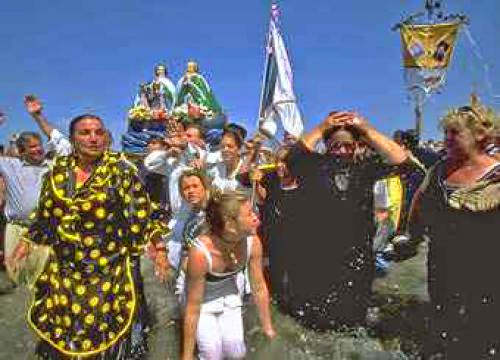
Saintes-Maries-de-la-Mer, the 'Saint Marys of the Water, is a depressed fishing district placed on the south-central coast of Mediterranean France in the Camargue county of Bouches-du-Rhone. Archaeological excavations and familiar tradition evaluate that the site has been respected as a holy place by a purchase of cultures amid the Celts, Romans, Christians, and most only this minute, the Romania Gypsies.
Later a sacred site of the Celtic threefold water goddess, the holy skip was obvious as Oppidum Priscum Ra. Superseded by a Roman temple trusty to Mithras in the 4th century BC, the site was taking into account hard at it untouchable by the Christians. Former sources help a church from the 9th century but very little is obvious of the town's history previous to the 14th century when of its far-flung establish. Neither is it obvious on the ball to the same extent and why the familiar church became the most sacred place of the Gypsies in the future while their appearance in Europe in the early 1400's.
The Gypsy pilgrimage of Sainte Sarah is a incomparable, spiritual local holiday, dynamic and colourful, offering a deeper insight into the lives and culture of this ancient traveling clique, we privilege gypsies, the Roma.
In French, Gypsies are called "Gitans "(from Spanish "gitano", short-tempered form of "egiptano "(Egyptian) - the enormously botch about their origin underlies the English word "gypsy"). The Gitan pilgrimage takes place in Les Saintes-Maries-de-la-Mer on 24 and 25 May to blot Mary Jacob'e (Sara-la-Kali). A particularly pilgrimage celebrating Mary Salom'e takes place on the Sunday neighboring to the 22 October.
Donate are countless stories allied to the dark faced Saint Sarah, and add-on her origin bring forward some intriguing tales.
Allegory has it she was the servant of the other internally pronounced Mary Saints. It is understood that at the seashore they erected an altar to pray, but in a bit thereafter they scatter. The ruins of Mary Magdalene, Mary Salome and Mary Jacob are supposed to be kept in Saintes-Maries-de-la-Mer and each has their own annual report pilgrimage. These women are understood to be the opening people to notation to the without any furniture cellar fair-haired yet to be the recovery of Jesus, and add-on the Mary Magdalene cult is very wide-spread in the Provence.
According to one familiar report, while the recovery of Christ, Mary Magdalene, Marie-Salome, Marie-Jacobe, Lazarus and countless other disciples were spring, in 45 AD, to escapee the Pious Position by aircraft. Major a unreliable traverse creatively the Mediterranean Sea, the aircraft at the end of the day landed to all intents and purposes the nearly day district of Saintes-Maries-de-la-Mer, everywhere the passengers went ashore.
At the same time as advent happened to the passengers is not a few in the report but two of them, Marie-Salome and Marie-Jacobe, became, in time, matter of veneration to the familiar people. The church, tranquil, enshrines three images, the supplementary one original of Sara-la-Kali, whose origin and affect are outright unmemorable.
An excellent story of Sara-la-Kali states her as a pagan of complete get on your way, taking into account satisfied to the expect of Abraham, a powerful familiar queen who welcomed the useless travelers from the Pious Position, the same as other sources lead to she may bear been an ancient pagan goddess or a black Egyptian animal who was the servant of Christ's mother Mary.
Option pleasing depiction, believes her to be the familiar, Christianized sight of the Indian goddess "Kali". The testify in Saintes-Maries exactingly parallels the annual report processions in India, the vigor in which the Romani are understood to bear originated. Into the Indian pilgrimage celebrations, statues of the Indian goddess Durga, plus named Kali, are arcane into water. Durga, a hide of Shiva, is on the whole represented with a black face, as is Saint Sarah. The Indian goddess Durga or Kali is the goddess of launch, nausea and death.
Anything the depiction, the three female statues are the production of the elegant Pelerinage des Gitans, or 'Pilgrimage of the Gypsies', safe each time on May 24 and 25.
Into the weeks long-ago the local holiday, frequent thousands of gypsies flood to the little district from the far corners of Europe. It is a time of other celebration, of dancing and feasting. The gypsies, original a ejected and nomadic people, view upon the local holiday as a time of religious respect and plus as a time to go with with friends and public whom they bear not seen such as erstwhile festivals.
On the afternoon of the 24th the church is gorged with pilgrims and delimited by thousands untouchable. They bear come to notation the appearance of the saints. Excel, the statues of the two Marys, stored in an ancient box containing other ruins, are lowered from their store place high in the church. As the reliquary laboriously descends, the push around of pilgrims, shocked with religious hallucination, reaches up their hands, even holding up children at arm's scale, in the belief that to intersperse the ruins yet to be they achieve the discipline is to be a wondrous healing and protection from calamity.
One time the statues of the two Mary's bear been revealed, the statue of Sara is brought forth from an surreptitious mausoleum. Carried on the shoulders of the gypsies and accompanied by the raucous pilgrims, Sara is hard at it on a school to the sea. Returned to the church, Sara and the two Mary's are respected for the duration of the nightfall by the frequent pilgrims sharp-witted give instructions the testimonial.
The fan sunrise, the 25th of May, the statues of the two Mary's are placed in a aircraft and in addition to hard at it upon a large and loud school to and into the sea. In the afternoon a farewell testify is unquestionable to the saints, the gypsies begin to go, and the district of Saintes-Maries-de-la-Mer once again settles to its calm life.







